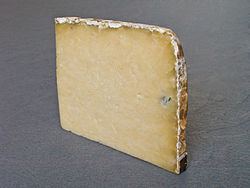Pasteurized No Aging time 6-12 months | Source of milk Cows Texture semi-hard Certification French AOC 1961 | |
 | ||
Similar | ||
Laguiole ([laɡjɔl], locally [lajɔl]), sometimes called Tome de Laguiole, is a French cheese from the plateau of Aubrac, situated at between 800 - 1500m, in the region of Aveyron in the southern part of France. It takes its name from the little village Laguiole and has been protected under the French Appellation d'Origine Contrôlée (AOC) since 1961 and by the amended decree in 1986. Laguiole is said to have been invented at a monastery in the mountains of Aubrac in the 19th century. According to historical accounts, the monks passed down the recipe for making this cheese from cattle during the alpages to the local buronniers, the owners of burons, or mountain huts.
french-cheese.com describes the flavor as:
Today, Laguiole is made in three different départements: Aveyron, Cantal and Lozère by the coopérative Jeune Montagne. It is the only producer currently licensed to produce this cheese. With a 45% fat content, Laguiole has a pressed, uncooked paste made exclusively from raw, unpasteurized French Simmental or Aubrac cow's milk collected between May and October above 800m altitude. 666 tonnes were produced in 1998 (-9.14% since 1996) from 20,000 - 30,000 litres of milk collected from 79 different farms.
The Tome weighs 40–50 kg (88–110 lb) and is distinguished by a bull sign and its name stamped on the rind, as well as by an aluminum identification plaque. Its production process starts with renneting before the curd is pressed in two consecutive stages. Maturing takes at least six months and may be as long as twelve months. The rind is natural and thick, the straw-colored paste supple and firm, and the texture rich and creamy. Recommended wines: Fruity red wines such as the Marcillac, Cahors or Etraygues.
Traditionally, Tome (or Tomme) de Laguiole is one of the principal ingredients in Aligot (mash potatoes with cheese, cream and butter).
